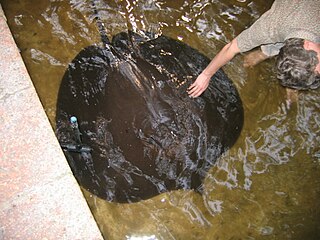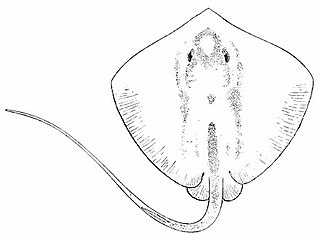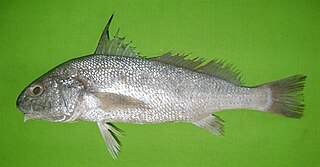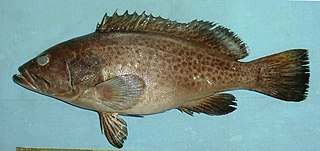
Pieter Bleeker was a Dutch medical doctor, ichthyologist, and herpetologist. He was famous for the Atlas Ichthyologique des Indes Orientales Néêrlandaises, his monumental work on the fishes of East Asia published between 1862 and 1877.

Wobbegong is the common name given to the 12 species of carpet sharks in the family Orectolobidae. They are found in shallow temperate and tropical waters of the western Pacific Ocean and eastern Indian Ocean, chiefly around Australia and Indonesia, although one species occurs as far north as Japan. The word wobbegong is believed to come from an Australian Aboriginal language, meaning "shaggy beard", referring to the growths around the mouth of the shark of the western Pacific.

The scaly whipray or Bengal whipray, is a species of stingray in the family Dasyatidae, found in the tropical Indo-West Pacific oceans from the Red Sea and Mauritius to Indonesia. Its width is up to 22 cm (8.7 in), and it may reach 65 cm in total length.

Ebosia is a genus of marine ray-finned fishes belonging to the family Scorpaenidae, the scorpionfishes. They are known as falcate lionfishes. They are native to the Indian and Pacific Oceans.

The giant freshwater stingray is a species of stingray in the family Dasyatidae. It is found in large rivers and estuaries in Southeast Asia and Borneo, though historically it may have been more widely distributed in South and Southeast Asia. The largest freshwater fish and the largest stingray in the world, this species grows up to 2.2 m (7.2 ft) across and can reach up to 300 kg (660 lb) in weight. It has a relatively thin, oval pectoral fin disc that is widest anteriorly, and a sharply pointed snout with a protruding tip. Its tail is thin and whip-like, and lacks fin folds. This species is uniformly grayish brown above and white below; the underside of the pectoral and pelvic fins bear distinctive wide, dark bands on their posterior margins.

Himantura is a genus of stingray in the family Dasyatidae that is native to the Indo-Pacific. In a 2016 taxonomic revision, many of the species formerly assigned to Himantura were reassigned to other genera.

Halichoeres are a genus of wrasses found in the Atlantic, Indian and Pacific Oceans.

The reticulate whipray or honeycomb stingray is a species of stingray in the family Dasyatidae. It inhabits coastal waters in the western Indian Ocean including the Red Sea, Natal and the Arabian Sea; also a Lessepsian transmigrant in the eastern Mediterranean. A large species reaching 2 m (6.6 ft) in width, the reticulate whipray has a diamond-shaped pectoral fin disc and an extremely long tail without fin folds. Both its common and scientific names refer to its ornate dorsal color pattern of many small, close-set dark spots or reticulations on a lighter background. However, the reticulate whipray is only one of several large spotted stingrays in the Indo-Pacific which, coupled with the variability of its coloration with age and locality, has resulted in a great deal of taxonomic confusion.

The pink whipray is a species of stingray in the family Dasyatidae, with a wide but ill-defined distribution in the tropical Indo-Pacific from southern Africa to Polynesia. It is a bottom dweller that generally inhabits shallow water under 70 m (230 ft) deep, in sandy areas associated with coral reefs. Individuals exhibit a high degree of fidelity to particular locations. The pink whipray has a diamond-shaped pectoral fin disc wider than long, with a broad-angled snout and a very long, whip-like tail without fin folds. It has only a few small thorns on its back and is uniform brownish to grayish pink in color, becoming much darker past the tail sting. This large ray can reach 1.8 m (5.9 ft) across and over 5 m (16 ft) long.

The Jenkins' whipray is a species of stingray in the family Dasyatidae, with a wide distribution in the Indo-Pacific region from South Africa to the Malay Archipelago to northern Australia. This large species grows to 1.5 m (4.9 ft) across and has a broad, diamond-shaped pectoral fin disc and a whip-like tail without fin folds. It has a band of heart-shaped dermal denticles running from between the eyes to the tail on its upper surface, along with a characteristic row of large spear-like thorns along the midline. It is uniform yellowish brown above, becoming grayish on the tail past the stinging spine, and white below; there is apparently a spotted color variant that had previously been described as a different species, the dragon stingray.

Acanthurus polyzona, commonly known as the black-barred surgeonfish or zebra tang, is a tropical fish found in coral reefs in the western Indian Ocean. It was first described in 1868 by the Dutch ichthyologist Pieter Bleeker, who gave it the name Rhombotides polyzona; it was later transferred to the genus Acanthurus, becoming Acanthurus polyzona.
The tubemouth whipray is a little-known species of stingray in the family Dasyatidae, named for its distinctive, highly protrusible jaws. It is found in shallow, brackish water near mangrove forests and large river mouths along the coasts of southwestern Borneo and southern Sumatra. Measuring up to 1 m (3.3 ft) across, this species has a diamond-shaped pectoral fin disc with an elongated, pointed snout and broadly rounded outer corners. The upper surface of the disc is a plain grayish or brownish in color, and covered by small, flattened dermal denticles. The tubemouth whipray is relatively common at present, but is heavily pressured by habitat degradation and coastal fisheries. The International Union for Conservation of Nature (IUCN) has listed it as Vulnerable.

Himantura alcockii, the pale-spot whip ray, is a species of stingray in the family Dasyatidae. It is found in coastal regions including estuaries, in the Indian Ocean. As presently defined, it is probably a species complex.

The blackedge whipray is a little-known species of stingray in the family Dasyatidae, found in the coastal waters of the Bay of Bengal and the Gulf of Mannar. Attaining a disc width of 1.8 m (5.9 ft), this species has a diamond-shaped disc with two small concavities on either side of the snout tip, and a long, whip-like tail without tail folds. It is characterized by large thorns with star-shaped bases scattered over the disc, and by the wide, black marginal bands on the underside of the disc. The International Union for Conservation of Nature (IUCN) currently lacks sufficient data to assess the blackedge whipray beyond Data Deficient.

The leopard whipray is a little-known species of stingray in the family Dasyatidae, found in the Indian and Pacific Oceans from the Andaman Sea to the Coral Triangle. It is found close to shore at depths shallower than 70 m (230 ft), over soft substrates. Attaining a width of 1.8 m (5.9 ft), this species has a diamond-shaped pectoral fin disc with a pointed snout and an extremely long, whip-like tail without fin folds. Adult rays have a leopard-like dorsal pattern of dark brown rings on a yellowish brown background, as well as a row of enlarged, heart-shaped dermal denticles along the midline of the disc. Newborns and small juveniles have large, solid dark spots and few denticles. The leopard whipray is caught by fisheries in many parts of its range, primarily for meat.

The honeycomb whipray is a species of stingray in the family Dasyatidae, found widely in the shallow coastal waters of the Indo-Pacific from India to the Malay Archipelago. This large species grows to 1.3 m (4.3 ft) across and has a diamond-shaped disc with rounded corners and a projecting, pointed snout. Its tail is long and whip-like, without fin folds. Adults have a striking dorsal color pattern consisting of large, dark brown rings and reticulations delineated by thin yellow lines, while juveniles have a pattern of large dark spots. This ray can also be distinguished from its similar relatives by an enlarged, pearl-like dermal denticle at the center of the back, which is followed by a few thorns. The International Union for Conservation of Nature (IUCN) has assessed the honeycomb whipray as endangered, as it faces heavy fishing pressure and habitat degradation across much of its range.

The whitenose whipray is a species of stingray in the family Dasyatidae native to the eastern Indian Ocean and the western central Pacific Ocean, where it is found in shallow water including estuaries.

Chlorurus bleekeri, known commonly as Bleeker's parrotfish, is a species of marine fish in the family Scaridae.

Johnius amblycephalus, the bearded croaker, also known as the green-backed croaker or sharp-nosed jewfish, is a marine ray-finned fish belonging to the family Sciaenidae, the drums and croakers. This fish is found in the Indian and Pacific Oceans.

Epinephelus bleekeri, the duskytail grouper, Bleeker's grouper or Bleeker's rockcod, is a species of marine ray-finned fish, a grouper from the subfamily Epinephelinae which is part of the family Serranidae, which also includes the anthias and sea basses. It is found in the Indo-Pacific region where it is associated with shallow banks.




















